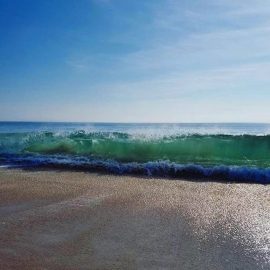Potential Outer Banks Energy Resources
 The Outer Banks has always been known as a place of abundant natural resources. After all, fishing has been legendary since before the first European footprint marked the beach. Visiting guests regularly come to enjoy the natural beauty of the area, and now we can add energy to the list of our abundant resources.
The Outer Banks has always been known as a place of abundant natural resources. After all, fishing has been legendary since before the first European footprint marked the beach. Visiting guests regularly come to enjoy the natural beauty of the area, and now we can add energy to the list of our abundant resources.
Beginning in the summer of 2016, the Bureau of Ocean Energy Management (BOEM) will be offering a 122,000 area block of leases for sale. This is known as the Kitty Hawk Wind Energy Area (WEA). Conservative estimates put the potential at 2,000 MW of energy which is enough to power a city with a population greater than 600,000.
Energy production is some time away, and those who purchase lease rights have to obtain a number of permits and navigate through several hoops. One thing that’s apparent is that of all the potential energy resources off the Outer Banks coastline, wind energy is the closest to being utilized.
It is not, however, the only potential renewable energy resource. At times passing just 12 miles from the Point, the Gulf Stream comes closest to the continental United States at Cape Hatteras. The amount of water being transported is so massive that it seems to defy description.
Mike Muglia, who is heading the Coastal Studies team researching the Gulf Stream energy development potential, described it as “ . . . 45 times greater than the entire flow of every river on earth is what we have off Cape Hatteras.”
There is a long way to go before we know if energy can be extracted from the Gulf Stream and the technical problems are huge.
For example, the Gulf Stream is not constrained in its flow and its location is not constant. Mike described it as a squirting garden hose that no one is holding. Much of the work being done now is in trying to predict where the Gulf Stream will be at any given point in time.
Indications are that there may be additional resources available. The Manteo Block, as it was called 30 years ago, lies 35 to 40 miles west of Salvo in a limestone outcropping that geologists feel is consistent with oil reserves. There was considerable controversy spearheaded by Outer Banks residents surrounding attempts to develop the area in the late 1980s and early 1990s.
A presidential moratorium on offshore drilling put an end to attempts to initiate exploration of the site. In 2014 President Obama lifted the moratorium on developing East Coast gas and oil reserves. However, his executive order created a 50 mile buffer placing the Manteo Block within this zone.
There are some other possibilities on the horizon. The staff of the Field Research Facility (the Duck Pier) are talking to a number of companies who have developed systems to convert wave energy into electric power. These would be small demonstration projects to determine if the systems were working as proposed. Generally the East Coast, and the Outer Banks in particular, are not considered good candidates for wave energy. Wave energy works best in areas where the waves are constrained, and the Outer Bank’s wide sandy shoreline does not meet this criteria.
One additional renewable energy source, Compressed Air Energy Storage (CAES), is cutting edge technology. There are two Compressed Air Energy Storages in operation worldwide, one in Germany and the second in Alabama. Ocean CAES or OCAES is still on the drawing boards, but imagine if the research from these scientists and engineers proves to be a viable energy source. This is the type of discovery that would revolutionize how we think of renewable energies.
One push back against renewable energies is that their sources are intermittent; no sun limits solar energy and calm winds result in limited wind energy. The OCAES system, proposed by Drs. Ro and Mazzoleni at NC State, would use an air compressor powered by the energy from a renewable platform and store the compressed air for later use.
The principal is simple, similar to the release of air from a balloon. When the compressed air is released, it turns a turbine and creates electrical power. Land based CAES systems require huge storage capacities; abandoned salt mines are currently used in Alabama and Germany. The advantage to storing the compressed air under the sea is that it can be stored anywhere. The only requirement is the ocean depth must be at least 1,800-1,900 feet to provide adequate pressure.
There is still a long way to go before we see any energy from an OCAES system, but it is exciting to know that this source may be on the horizon.
